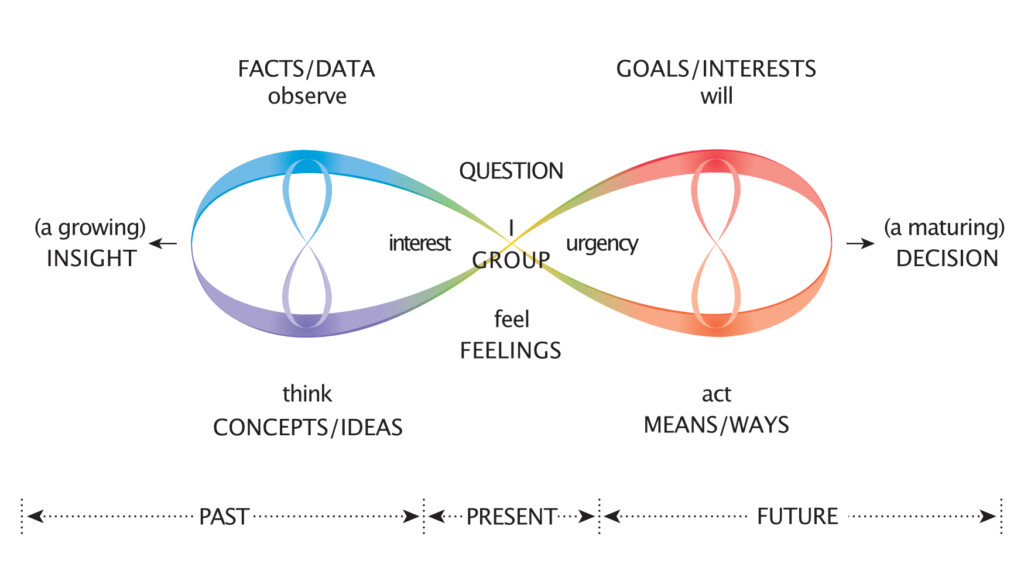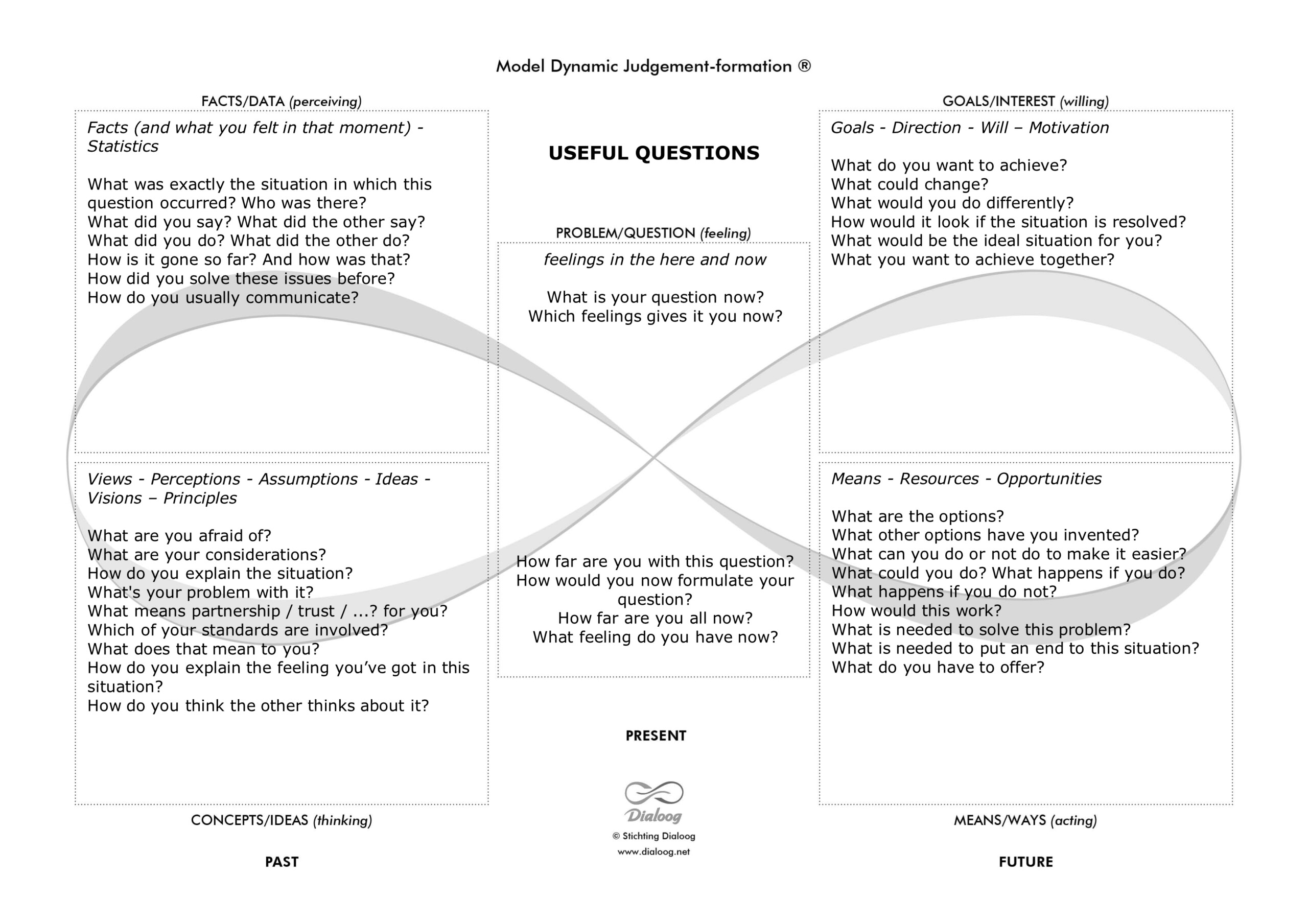The rhythmic movement of Dynamic Judgement-formation.
Ron Henkes and Leonarda Telling
Introduction
Many models of judgement- and decision-making processes often work logically and rationally while in practice things are often more chaotic. The model Dynamic Judgement-formation distinguishes itself by a different logic: the logic of rhythm, feeling and polarity. As a music lover, you might be able to imagine something about that.
This model is more resistant to the chaos of conflict. It makes judgemental processes more transparent as a rhythmic movement between poles, for example, the polarity between positions and interests, past and future.
You only know what is really going on if you regularly work through all the poles of the model. And: where does someone tumble back into the standpoints, what feelings are affected and how do you get back in the direction of interests?
Feelings as a starting point
In any conversation process, all kinds of feelings go through you. This happens to those involved in the conflict as well as to the mediator. As a mediator, you have to be careful. Before you know, these feelings will guide you in a subconscious way and you will have become part of the conflict system instead of a neutral facilitator.
How does Dynamic Judgement-formation help you stay out of it? How do you get more clarity about what is going on and how can you, as a process facilitator, respond to that?
A simple incident from daily practice!
An ordinary Friday morning in an ordinary health centre. I’m setting up the workspace to supervise a peer to peer coaching of people from outside.
We start at 10 o’clock and at a quarter to ten a colleague comes running in. He normally uses this room, but we had agreed to swap for today because I need a little more space for my group.
‘What are you doing? I’m already late, my 9:30 appointment must be waiting, I was stuck in traffic! And now you’re in my room too!’
I am speechless for a moment, but I also see the first people of my group coming in. I turn to my colleague:‘Terrible for you that you are so late because of that traffic jam. Maybe you forgot that we had agreed that I would use this room for the group today. So I’m staying here and my room is at your disposal!’
‘I don’t know anything about an agreement, I want to be in my room!’
‘No you can’t, but what’s wrong with that other room?’
‘Well that table is so weird and I can’t sit like that with my visitors to have a proper conversation!’
‘What can we do then that you can sit comfortably?’
‘Then it would have to be turned and …..’
‘Come on, we’ll grab it and put it down like that!’
‘OK? Have a nice day!’
‘Fortunately, thank you’
At the end of the morning, my colleague comes up to me and asks me what exactly I did. He is surprised at the effect of our brief conversation. He acknowledges that he was pretty upset and, thanks to our little talk, was able to get back to work quickly and happily. Using the Dynamic Judgement-formation Model (DJF) I explain what I have done.
What happened between my colleague and me?
The reason for the conversation was his frustration about being late because of the traffic jam and the idea that his customer was already waiting for him and he couldn’t get to his usual spot either. In a split second, two interpretations of the situation are pitted against each other. (I know of no appointment versus I agreed to this with you).
My acknowledgement of his frustration of being late creates the first relaxation and allows me to reiterate my own importance and give him my facts: the agreement that we will swap rooms this morning.
So every judgement process starts with a feeling.
If he then goes into resistance again, I ask him about what is behind the resistance: what is wrong with…? He indicates what he wants: a place where he can have a pleasant conversation with his client. The moment I take that seriously and indicate that I want to think along to make that room to his liking, the ice is quickly broken.
Dynamic Judgement-formation
The study by Lex Bos, ‘Judgement formation in groups’ (Wageningen, 1974), showed that each judgement formation process passes through the five fields of facts, concepts, feelings, goals and means in a completely individual way (see figure 1). Bos was thus the first to demonstrate that this is not a linear process, but a dynamic one that is driven by the underlying need, concern or question of the participants in the conversation.
 Figure 1 Model Dynamic Judgement-formation © Dialoog Foundation
Figure 1 Model Dynamic Judgement-formation © Dialoog Foundation
In this example of my colleague and me, the conversation starts in the here and now with my colleague’s frustration that I am busy in ‘his’ room (field of Feelings, the feelings in the here and now).
Then it’s about the facts (Facts Field, that which everyone perceives as factual): according to me, there is an agreement that we will swap rooms that day, according to him he is just using his room. I will receive my peer to peer coaching group later at 10:00 AM, his client is already waiting and has an appointment with him at 9:30 AM.
To my question ‘what is wrong?’ he goes in the direction of his conceptions and thoughts about the situation (field of Concepts, the explanation, thoughts about, the explanation of): I cannot work like this, a good conversation requires a different table arrangement.
Implicitly, we touch the field of Goals (what you want to achieve, ideals, interests): it is important for him to start quickly and have a good conversation, I want to have the opportunity to accommodate the whole group and also start on time.
The question of what we can do to make him comfortable in that room brings in a new, relatively obvious point of view that turning the table is also possible and helps both of us (field of Means: options, possibilities, offers).
Then we come back to the middle field of Feelings: Fortunately, thank you!
From resistance and a potentially escalating conflict, the situation has transformed into two satisfied people who can go back to work, more or less relieved. A change from the primary reaction to a relative relief.
What did we do? Acknowledged the feelings at play, tackled the problem head-on and created the willingness to look for solutions, such that in the follow-up interview he emphasised how remarkable the shift was that had taken place in his feelings.
Of course, this is a simple example from daily practice and is mainly meant to illustrate the model. However, more generalised, we dare to say that if you want to contribute to resolving a conflict, it is necessary that you clarify
- what feelings play a role with the participants in the conflict (Feelings Field)
- what they are about, i.e. what their facts are (Facts Field)
- what they think about it, how they view it, what standards they have in mind (Concepts Field);
- what they ultimately want, what they are aiming for, what is important (Goals Field)
- and which possibilities and ways of solving them, including thinking through consequences and limitations, are available (Means field).
Three polarities play a role in these facets that are recognisable in common conversation processes and certainly in conflict situations: The polarity
- between past and future
- between facts and concepts
- between goals and means.
Bos’ research shows that a balance between these polarities naturally arises in a good conversation. If someone spends some time talking about the past, a need to talk about the future naturally arises: what do you actually want from it? Or if someone only presents facts, the logical movement is to arrive at an interpretation (field of concepts). When you are talking about solutions, the need to look at the future automatically arises: what did we want to do with it again?
In these polarities, the basis is always in the middle: What question do we have in mind? In what way does it occupy us?
The DJF model describes a process that mediators know very well, and it enables them to look at this process with more awareness and to intervene in a more targeted way.
Because in conflict situations, the conversation process does not run by itself. Looking at the process through the DJF model’s ‘spectacles’, one can observe its dynamics at meta-level and follow its course.
Where is the conversation moving, past-present-future? Suffering in the present from the past and wanting to solve something with a view to and for the future. Do the participants only draw conclusions without stating the facts on which they are based? Or are some of the participants setting their own goals so high that there is no prospect of a joint solution in the middle ground? Does someone keep falling back on his own assumptions in the field of concepts? Is there rigidity in the proposed solution? Are feelings overemphasised or left out of the conversation?
That is why it is important for the mediator to get the aspects of all the fields above the table and to start recognising one-sidedness in the stories. In this way, as a mediator, you can use the DJF model to keep an eye on the process and, where necessary,
- ask questions from a field that the conversation is not (yet) moving towards;
- continue asking questions in one of the fields when the information in the field is still too limited or too general;
- make a conscious switch to another field if you notice that the conversation is stuck in a repetition of viewpoints. If someone repeatedly mentions that the only solution is that…. (someone is stuck in their own solution in the Means field), you can switch to the Goal field and ask the question: What is solved if you choose this solution? (see Figure 2)

Figure 2 Useful questions in the Model Dynamic Judgement-formation
- In the dynamic between the Facts and the Field of Concepts, it is repeatedly said at the interview table, for example, that the situation is hopeless, without it being clear on what this conclusion is based. In order to get someone out of the assumptions in the Conceptual Field (‘the situation is hopeless’), you could ask a question from the Factual Field such as: What exactly shows you that you find the situation so hopeless?
- switch from past to future, or to the here and now, if it is not clear how a participant relates to the information from the past and/or future. The different participants at the table are not always talking in the same direction, one is just regurgitating old skeletons (past-oriented) while the other is already working on his solutions (future-oriented);
- Returning to ‘Start’, the present in the middle of the model: Why are you sitting here again? What was the issue and what is it now? How far have you got? And how does it feel? What question do you want to move on with now?
- summarise using the information from all fields;
- feedback the process that you have observed at meta-level to the participants in the form of a conversation pattern.
In this way, the DJF model can serve as a process compass in all phases of the mediation process. For example, in the exploration phase to get from the past to the future. The facts and concepts in a row towards interests (goal field). In the negotiation phase, the alignment of interests and possibilities (goals and means field), in the conclusion phase the alignment of agreements and the question of whether all questions and associated feelings have been addressed (from means back to the feelings field).
Introvision (self-reflection)
As indicated at the beginning of this article, as a facilitator, however neutral you want to be, you also have to deal with your own feelings. In most cases, you use these feelings unerringly to follow the conversation and make your interventions. At the same time, you sometimes cannot escape feelings of sympathy and antipathy for one person or another at the table. As a mediator, you have to remain neutral and impartial, but we are all human.
Through self-reflection on the situation in the moment, but also before or after, you help yourself recognise your feelings and deal with them. Introvision, self-reflection with the help of DJF, helps you to gain insight into your feelings and to discover what it takes to deal with them properly. This application can be downloaded from www.introvisie.net.
Literature
Broek, M. van der, Praktijkboek Dynamische Oordeelsvorming. Zeist, Publisher Christofoor, 2014.
Bos, A.H., Oordeelvorming in Groepen. Wageningen: Landbouwhogeschool, 1974. Driebergen: Dialoog foundation, republished 2007
Information
Ron Henkes is an MfN-registered mediator, MfN assessor, trainer and teacher at the School of Mediation. He is a board member of Stichting Dialoog and responsible for the training in all applications of Dynamic Judgement-formation. He is co-author of Praktijkboek Dynamische Oordeelsvorming. (www.ronhenkes.nl)
Leonarda Telling owns the School for Mediation and has included Dynamic Judgement-formation as a methodology in the basic mediation training for professionals. She also works in business as an HRM/Legal consultant and advises teams and employees within organisations. (www.davinciconsult.nl)
This article was published in Tijdschrift Conflicthantering 2017-6, SDU, professional journal for mediators in the Netherlands.

Wow, awesome weblog format! How long have you ever
been running a blog for? you made blogging
look easy. The entire look of your site is magnificent, let alone the content!
You can see similar here najlepszy sklep